Minimizing Impacts to Wildlife from Livestock Infrastructure
Introduction
Livestock require certain infrastructure including fences and water developments. When structures are designed without wildlife considerations or are poorly maintained, they can form dangerous traps and present risks for wildlife. However, with a little planning and minimal effort, livestock infrastructure can be modified to reduce unnecessary wildlife injury and death, while effectively keeping livestock safe, healthy and contained. These changes are not only simple, but can reduce the long-term costs of labor, construction and maintenance of your livestock structures. The goal of this fact sheet is to provide best management practices to create inexpensive, effective and wildlife-friendly livestock infrastructure.
Fences
Why Build Wildlife-Friendly Fences?
Permanent fences are commonly used to delineate property boundaries, keep livestock contained within pastures and exclude other livestock. Some fence designs become too effective. Not only do they keep livestock in, but they also become barriers that cause problems for wildlife. When wildlife encounter a fence, they must either find a way to cross or become stranded on one side. This can prevent large animals from accessing important habitat or travel routes and can separate wildlife from their young. Species such as pronghorn, deer and elk can become entangled, leading to injury or death. Birds such as raptors or prairie-chickens sometimes collide with fences when they are difficult to see. This is not only detrimental to wildlife, but they come at a cost to livestock owners as well. Collisions and entanglements can weaken or damage fences, allowing livestock to escape and increasing the time and money spent on fence repairs. Building wildlife-friendly fences not only will help wildlife safely cross property, but also reduce fence maintenance costs over time.
Fortunately, functionality does not have to be compromised to build a wildlife-friendly fence in most circumstances. Depending on the purpose of the fence, there are several possible solutions that will allow wildlife to cross, while keeping livestock inside.
When You Need a Barrier
There are some cases in which a wildlife-friendly fence will not suit the needs of livestock or when wildlife are not desired in an area. In these cases, exclusion fencing, like woven wire or welded mesh wire, may be necessary to effectively contain goats, separate horses or keep wildlife out of kidding and lambing areas, hay stacks or gardens. Nevertheless, there are considerations that can be incorporated into exclusion fencing to offset their impacts in a wildlife-friendly way. Effective exclusion fencing to keep out deer and elk should be 7 to 8 feet tall, with a highly visible top wire or rail. Gates are best placed at the corners, where a trapped animal is most likely to search for an escape.
Avoid using more exclusion fencing than is needed. Think about which pastures or areas require heavy-duty and tall fencing to be effective. How do these pastures fit into the landscape? Do they block access to important wildlife habitat such as wetlands, riparian areas and sources of food, shade or cover? Consider placement of exclusion fencing so wildlife can still travel freely to these critical areas.
Similarly, think about which pastures may be suitable for wildlife-friendly fencing. This might include interior pastures or pastures that are only used seasonally. By prioritizing where exclusion fencing is needed and where it is not, labor and expense of constructing fences can be reduced, while allowing wildlife to access important habitat.
Fence Considerations
Before embarking on a new fence construction project or modifying existing fences, there are a few important factors to consider.
First, think about the purpose of the fence. If the fence will primarily be used to
mark a boundary line and not contain livestock, then a wildlife-friendly fence can
be constructed. If the fence will be used to hold livestock, what kind of livestock
will it hold? Certain livestock may require a stronger fence than others. As discussed
above, exclusion fencing may be necessary for some animals. However, where exclusion
fencing is not needed, wildlife-friendly fencing is an effective and low-cost option.
Second, think about the layout of the property. How is the land used? Is it flat or
hilly? What plants grow there? What kinds of wildlife are seen? Based on answers to
these questions, consider where wildlife are most likely to be found. Avoid placing
fences across known travel routes or cutting off access to important resources such
as isolated trees and water. The terrain is another important factor. Building fence
along a steep slope increases the height an animal must jump to cross and should be
avoided where possible.
Finally, what kinds of wildlife will encounter the fence? Some species will require different types of fencing. For example, if the property is used by pronghorn, then the fence will require a taller bottom wire to allow pronghorn to pass underneath. Larger birds such as prairie-chickens will benefit from visibility markers. The types of wildlife will determine what kind of fencing is most appropriate for your needs.
Constructing Wildlife-Friendly Fences
When building a new fence, remember to fence only the minimum area required. Extra fencing requires additional materials and maintenance and creates unnecessary barriers for wildlife. Time, money and headaches will be avoided by fencing only the area needed to be fenced.
Once it is determined where the fence will be built, select the appropriate materials and dimensions. Choosing the right fence design can reduce the risk of wildlife injury and reduce the cost of fencing.
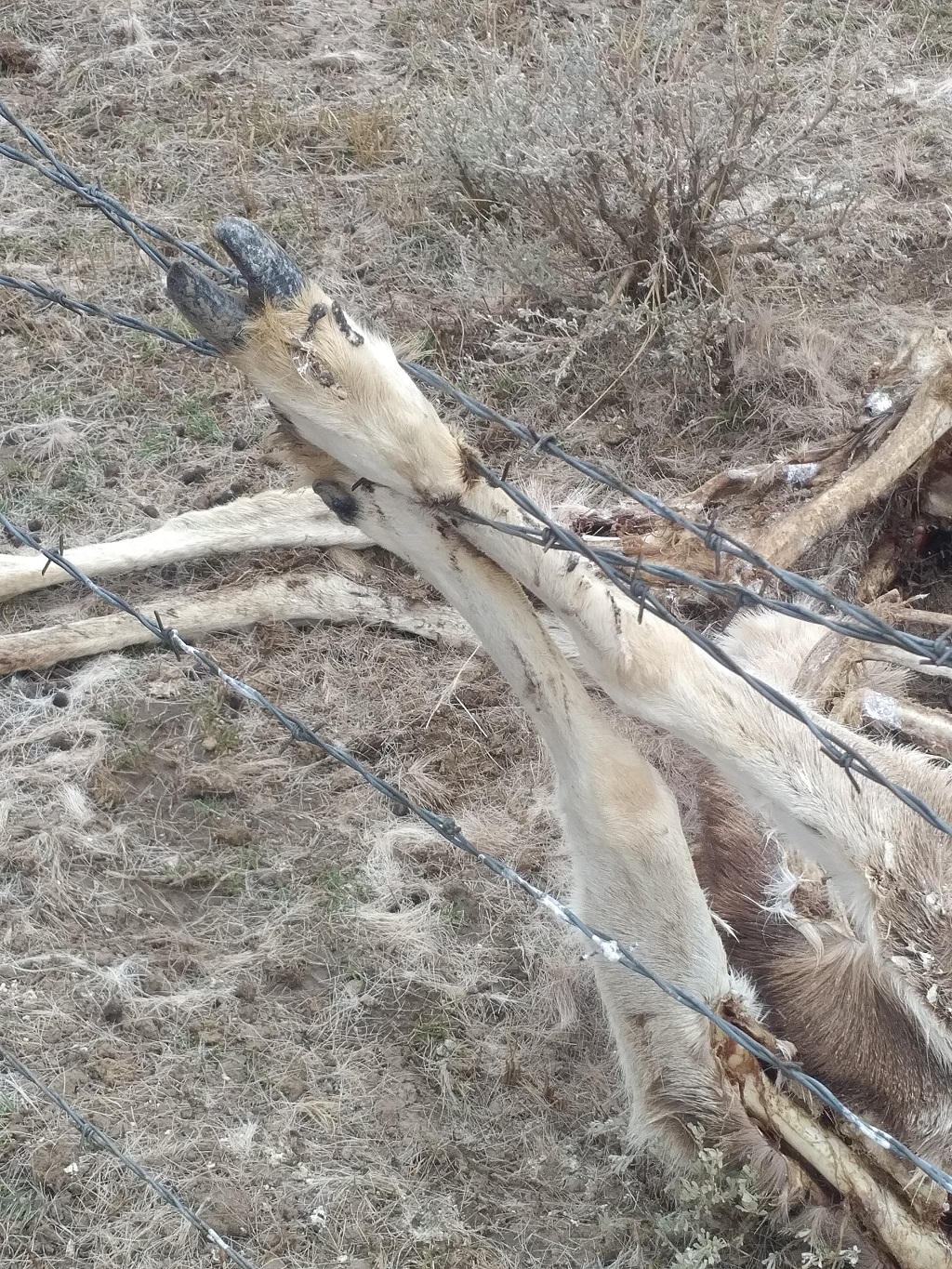
Loose wire is very dangerous for deer, elk and pronghorn. (Photo courtesy of Ben Robb)
Certain fence designs are more dangerous for wildlife than others. The most wildlife-friendly
designs are highly visible and allow wildlife to safely jump over, crawl under or
pass through a fence at designated points. Where possible, avoid fences that:
- are too high to jump over,
- are too low to crawl under,
- have closely spaced wires,
- have loose or broken wire,
- use barbed wire on the top or bottom strands,
- create a complete barrier,
- are difficult for animals to see, and
- are located on steeply sloped ground.

By having a smooth bottom wire 16 inches above the ground, this herd of pronghorn can safely move across the landscape. (Photo courtesy of Roswell BLM)
Wire type and spacing can make a big difference in reducing wildlife injury. The most dangerous design for wildlife is woven wire topped with barbed wire. Although this type of fence is useful for small livestock such as sheep and goats, it presents an impassable barrier preventing large animals from crawling under it. This is especially problematic for pronghorn, as they prefer to pass under wires rather than jump them. For animals that do jump, such as deer, the barbed wires on top can cause injury. Whenever possible, use only three or four wires for the fence, with smooth wire for the top and bottom strands.
The spacing and height of wires also is important, because entanglement in fences
is a major risk for wildlife. Deer and pronghorn are capable of jumping, but can get
their feet tangled when wires are loose or very close together. To avoid snagging
a jumping animal consider the following recommendations:
- use only three or four wires,
- the top wire should be no more than 42 inches above the ground for interior fences,
- leave at least 12 inches between the top two wires,
- the bottom wire should be at least 16 inches above the ground,
- smooth wires should be on the top and bottom,
- place passages for wildlife to cross (drop-down fence, gates, gaps, underpasses, etc.) at corners or important wildlife crossings,
- maintain tension on fence wire and
- attach visibility markers.
Smaller livestock such as sheep, goats or calves may require lower, more closely spaced wires. Below are recommended wire configurations for various livestock for interior fencing.
Table 1.
| Cattle or Horses | Sheep | |
|---|---|---|
| Top Wire | 40 to 42 inches | 32 inches |
| smooth | smooth | |
| Second Wire | 28 inches | 22 inches |
| barbed | barbed | |
| Third Wire | 22 inches | 16 inches |
| barbed | barbed | |
| Fourth Wire | 16 to 18 inches | 10 inches |
| smooth | smooth |
| Cattle and Sheep | |
|---|---|
| Top Wire | 38 inches |
| smooth | |
| Second Wire | 26 inches |
| barbed | |
| Third Wire | 18 inches |
| barbed | |
| Fourth Wire | 10 inches |
| smooth |
Adapted from Wyoming Game and Fish Department, 2004.) Note that Oklahoma has legal requirements for perimeter fencing. The recommendations listed above are for interior fencing. Consult The National Agricultural Law Center for current state regulations.
Vertical stays often are used to maintain wire spacing between posts. Stays may reduce
the risk of wildlife entanglement and improve fence visibility. Wildlife-friendly
stays should hang above the ground and be made of lightweight wood, fiberglass or
composite material. Wire stays are not recommended because they can be easily bent
by crossing wildlife and lead to further entanglement. To allow wildlife to pass between
wires, maintain 30 feet of free space between stays and posts.
To contain goats and deter predators from entering their pastures, welded net wire
or 10 strands of barbed wire is often used. Limiting the amount of this type of fencing
will allow safe wildlife passage within the property.
Horses often require taller fencing, since they are more likely to jump over fences than attempt going through them. They also will reach over the fence to feed, which can weaken it. Barbed wire is not recommended for horses, instead rail and pipe fencing are often used. These fence types are highly visible and when a 16-inch minimum height is used with 12-inch spacing between rails, this design can be wildlife friendly.
Electric fencing is another effective option for a variety of livestock. Although livestock are usually contained by electric fence, wildlife such as deer and pronghorn do not seem to mind it. This fence type may reduce the risk of wildlife damage, but the wires must be flexible enough to allow wildlife to cross over. Therefore, use the minimum recommended wire tension when attaching strands. However, be sure to maintain this tension throughout the lifetime of the electric fence to ensure that the wires do not become excessively loose. Loose wires can lead to entanglement of wildlife.
Visibility
Another primary concern of fences is visibility. Animals such as raptors, ducks and grouse (e.g. prairie-chickens) may not be able to see a wire fence until it’s too late. Collisions are especially likely to occur at dawn or dusk, when light is dim. Try to avoid fences across streams and ponds, as these are likely collision spots for bats and birds. Collisions not only harm wildlife, but also can lead to higher costs of fence repair and time spent searching for escaped livestock. Building highly visible fences will help animals see them from a distance and navigate more easily.
The materials chosen for the fence may make it more obvious to wildlife. Some livestock owners have had success using colored wires, particularly for the top strand. White is thought to be the most visible to wildlife. However, black or other bright colors may stand out better on the landscape during certain times of year. Using a rounded top rail is an alternative option. Although a top rail will increase the cost of the fence, it makes the fence very obvious and reduces the risk of injury to jumping wildlife.
Inexpensive solutions include hanging sections of PVC on the top wire, placing pieces
of colored tape or flagging and using vinyl markers. Vinyl markers can be used to
cover long stretches of the fence in very little time. They also are less likely to
fade or become lost than flagging or tape. The markers are made from trim strips of
white vinyl siding, which can be purchased at a local hardware store. Strips are cut
into 3-inch pieces and snapped onto fence wires using the plastic lip. For smooth-wire
fences, zip-ties or ferrules may be needed for attachment on either side of each marker
to prevent sliding. If the fence posts are 12 feet apart, markers should be placed
as follows:
- Top wire: four markers, with 4 feet between each marker and 2 feet between each post and the nearest marker.
- Middle wire: three markers, evenly spaced between the posts with 4 feet between each marker.
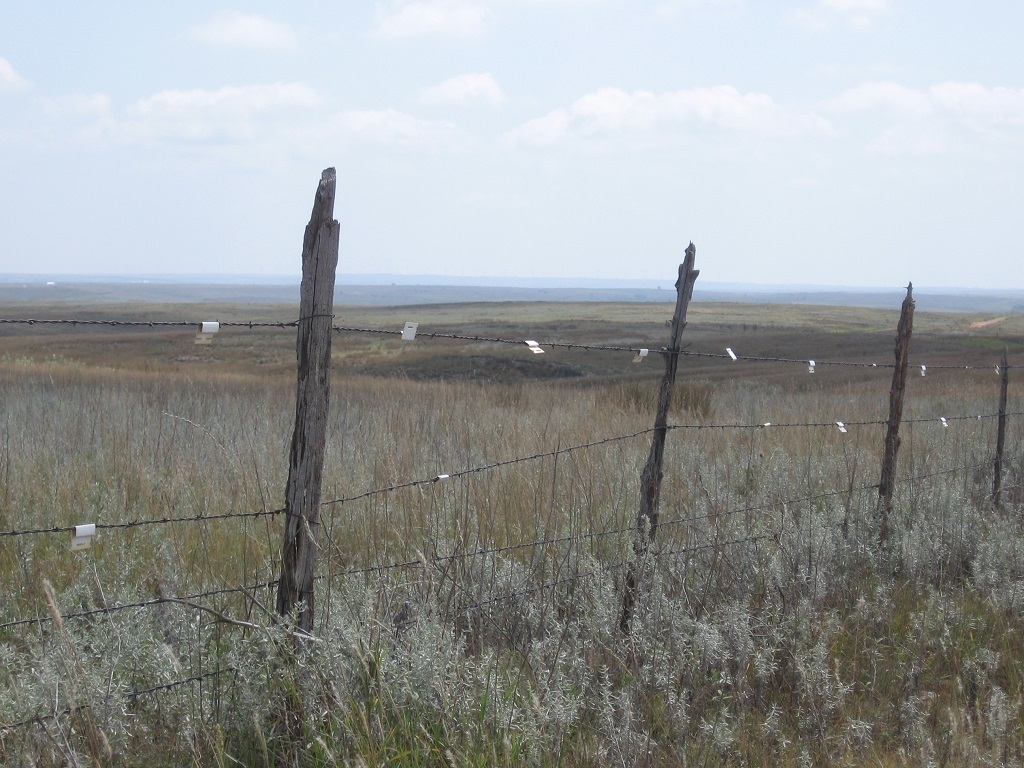

Vinyl siding can be modified to mark fences and help wildlife avoid collisions.
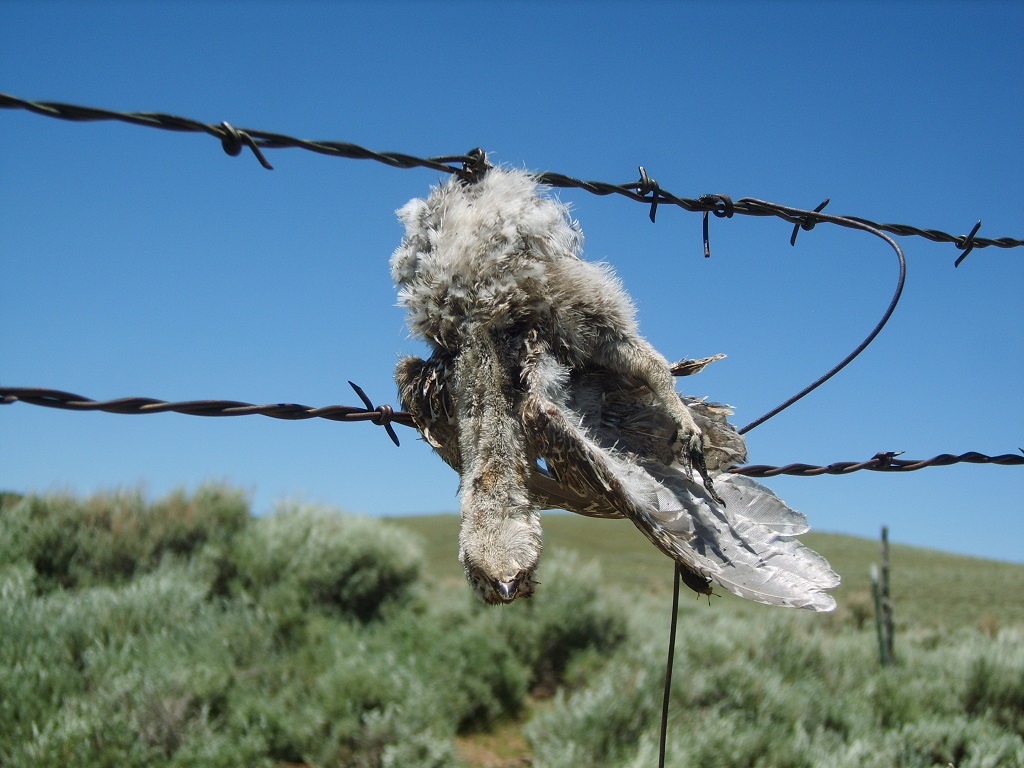
This grouse chick collided with a fence and was killed. Many collisions can be avoided by marking fences, especially in areas known to have high animal movement, such as near prairie-chicken leks and at deer, elk and pronghorn crossings. (Photo courtesy of Dave Dahlgren)
Solutions for Existing Fences
What if the property has existing fence that is not wildlife friendly? Fortunately, there are simple ways to modify existing fences to help wildlife cross.
Adjust wire heights and spacing where possible so wildlife can pass over or under the fence more easily. Wildlife crossings can be placed in existing fences to allow wildlife access to important travel routes and water sources. These include solutions such as lay-down sections of fence or underpasses. Underpasses are especially important for pronghorn, who prefer to crawl under fences. To create a pronghorn underpass, simply raise the bottom wire on two adjacent fence posts and secure. For pastures in which cattle or horses are kept, a goat bar underpass also is effective for pronghorn. This type of underpass is created by gathering the bottom two wires together and placing them into a piece of PVC pipe to create a taller opening. Similarly, wildlife gaps can be created in sections of fence by twisting two adjacent wires together to create an opening through which wildlife can pass under. Earthen escape ramps are sometimes used as well. These crossings can be expensive, but are effective to quickly move wildlife off of hazard areas such as major highways.
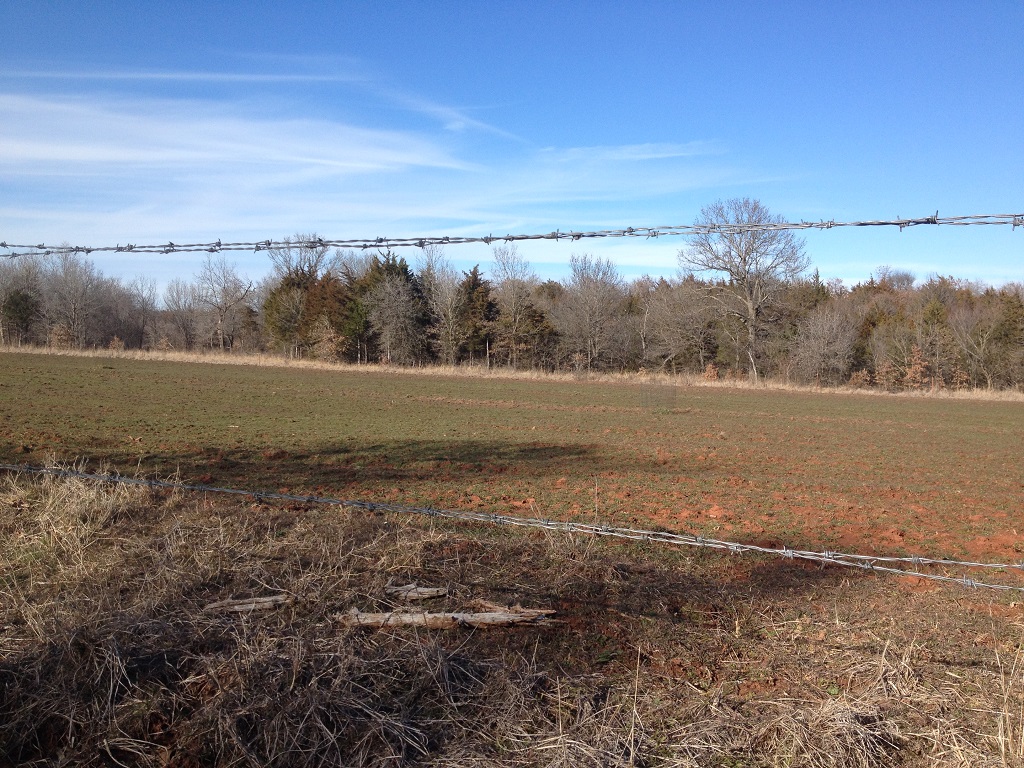
These wires were twisted together to create an opening for deer to pass through and gain access to a wildlife food plot. However, this presents some risk of entanglement as the wires are loose. It would be better to tighten the wires and raise the bottom wire to allow animals to pass under it.
Unused Fence
When fences become old and are no longer used, they pose hazards to wildlife as well as to people, pets and livestock. Many hunting and working dogs are injured each year due to old wire laying on the ground or buried and hidden in dense vegetation. Loose wires become traps that entangle animals as they attempt to cross. Even fences that are torn down and left flat on the ground can cause serious injuries if unsuspecting people or animals walk into them. As a safety precaution, the best strategy is to tear down and completely remove fences no longer in use. Cost share assistance may be available to help pay for this removal. Check with your local NRCS office about possible programs for cost share.
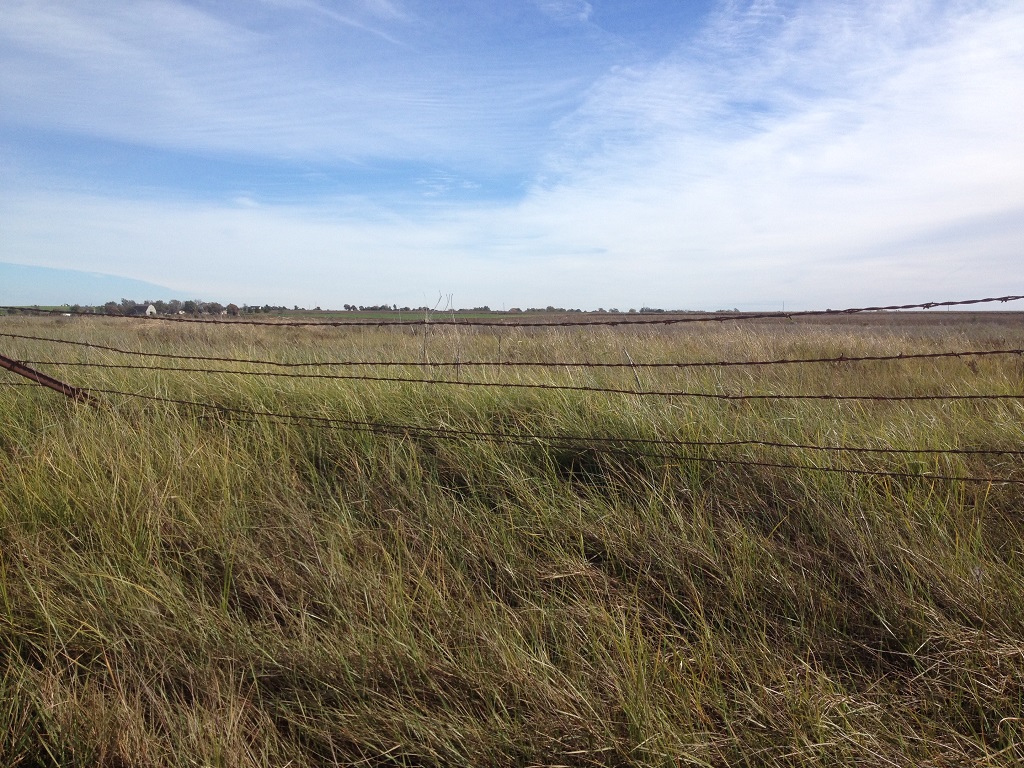
Old fences that are leaning at an angle can be a death trap for deer, elk, and pronghorn.
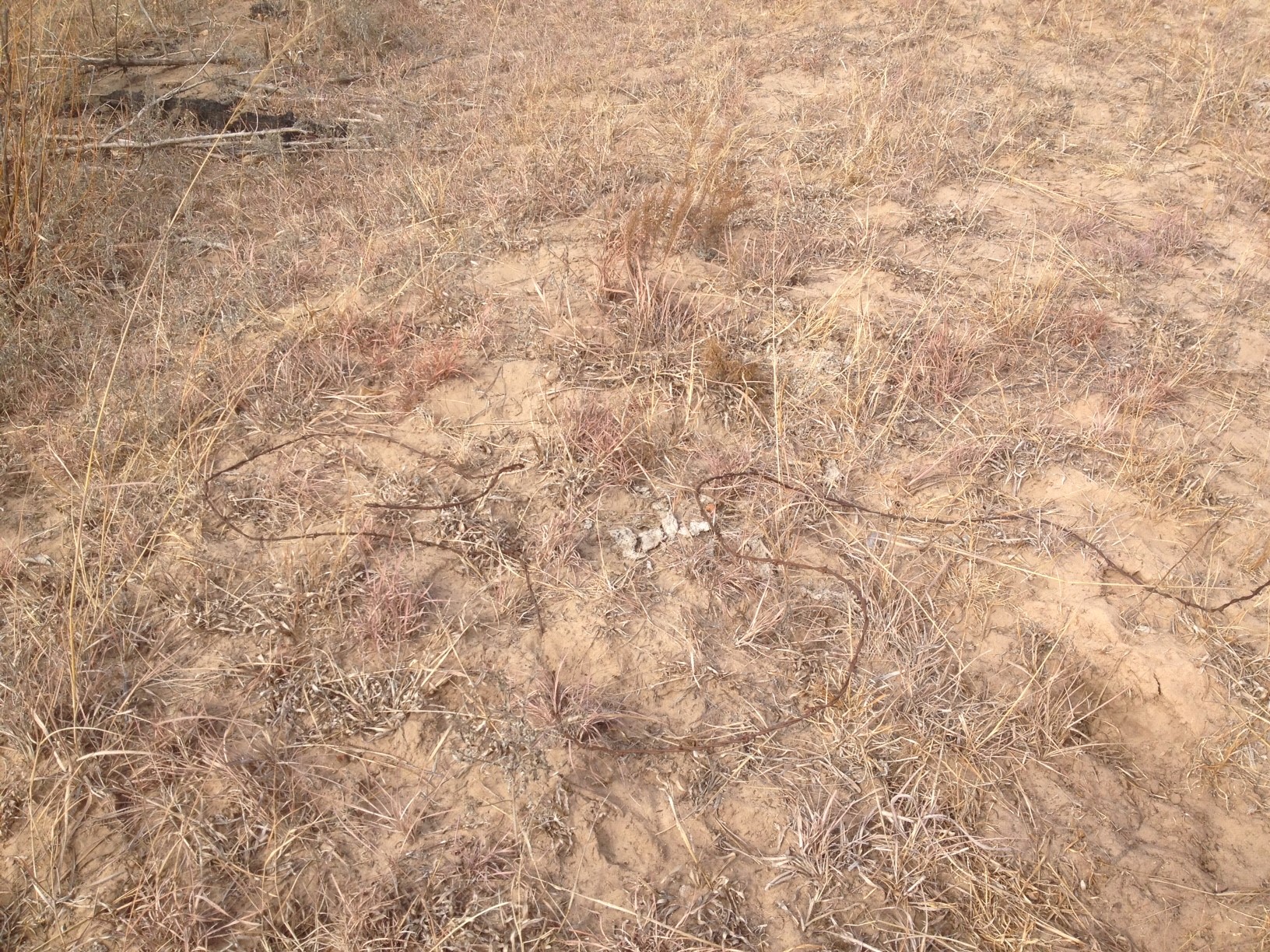
Old, loose wire can entangle animals. Additionally, working and hunting dogs frequently are injured when running through it. Whenever encountered, this wire should be removed.
Alternatives to Interior Fences
Most livestock producers install interior fencing to change animal grazing patterns or allow forage plants rest from grazing, but these objectives can also be accomplished in other ways. Strategic placement of salt, mineral or protein supplement can draw grazers to different areas and are not an additional cost, since they are already necessary. Patch burning, where only a portion of a pasture is burned using prescribed fire, also is very effective at attracting animals to burned patches and allowing other areas to rest from grazing. This practice provides high-quality forages, moves animals to desired areas and is very low cost relative to building new fences.
Another easy way to allow wildlife to pass through pastures is to leave gates open when livestock are not present. This can be done regardless of the type of fencing used.
Water Troughs
What’s the Problem?
Surface water is a requirement for livestock. A cow weighing 1,500 pounds can require 10 to 20 gallons of water per day, and daily water intake can increase with higher air temperatures or milk production. Water developments are therefore essential for meeting the water needs of livestock. These water developments appear to be a blessing to wildlife too. They can provide a reliable source of clean drinking water for many species. However, while deer, elk or a pronghorn may have an easy time getting a drink from a livestock trough, these structures can be dangerous for smaller animals such as birds, rabbits, bats, rodents and insects. Unless designed with wildlife in mind, a seemingly harmless trough can become a deadly trap.

These two cottontail rabbits could have easily escaped with a $15 escape ramp! Now, not only does the landowner have less wildlife on their property, they have a polluted tank that requires cleaning. (Photo courtesy of Roswell BLM)
Troughs, unlike natural water sources, often have slick or concave sides that are difficult to climb. Wildlife frequently fall inside and become trapped. Trapped animals will swim in circles around the rim of the tank seeking an escape, and many eventually become exhausted and drown. Not only does this lead to unnecessary death, but decaying animals pollute the water and pose health risks for livestock. Even excessive insect material can contaminate water. Contaminated water discourages cattle from drinking, which can impact feed consumption, weight gains and disease resistance. This means that animals trapped in water troughs can become a serious health problem for livestock. Diseases like leptospirosis, which is spread through the urine, can be spread from wildlife to livestock when animals are trapped in water troughs.
Therefore, installing escape structures on water troughs is not only a life-saver for small animals, but provides many benefits to livestock owners as well. Preventing wildlife from drowning reduces the labor of cleaning fouled tanks, prevents water contamination and may improve livestock health in the long run.
The most dangerous tanks for wildlife are those that have:
- low water levels,
- smooth or concave sides that are difficult to climb,
- nearby structures such as posts, wires or vegetation that can cause collisions and
- no wildlife escape features
When designed and maintained properly, a water trough will provide a healthy source of fresh water for both livestock and wildlife.
Outside the Trough: Wildlife Access
Certain trough designs are riskier for wildlife than others. Old tire troughs are extremely common, but these have curved sides that create a large overhanging rim. The rim then becomes an additional obstacle for a trapped animal to overcome. Similarly, metal storage tanks with open tops become dangerous when water levels drop below full. The deep metal sides are nearly impossible to climb for any wildlife. Although these trough designs pose additional risks, there are still simple ways to modify them to reduce wildlife entrapment. Knowing the size and shape of the trough will help determine an appropriate modification strategy.
Consider what is surrounding the tank. Vegetation and man-made structures can block wildlife access. Bats and some birds, such as nighthawks, often drink on the wing. They will swoop down on the trough to take a drink rather than perching on the edge. Tall structures near the tank or fences across the tank can cause collisions when bats and birds are swooping, causing them to fall into the water. Tall shrubs, posts and fence wires are especially problematic. When possible, avoid placing tanks next to or directly under these structures to reduce the risk of a collision.
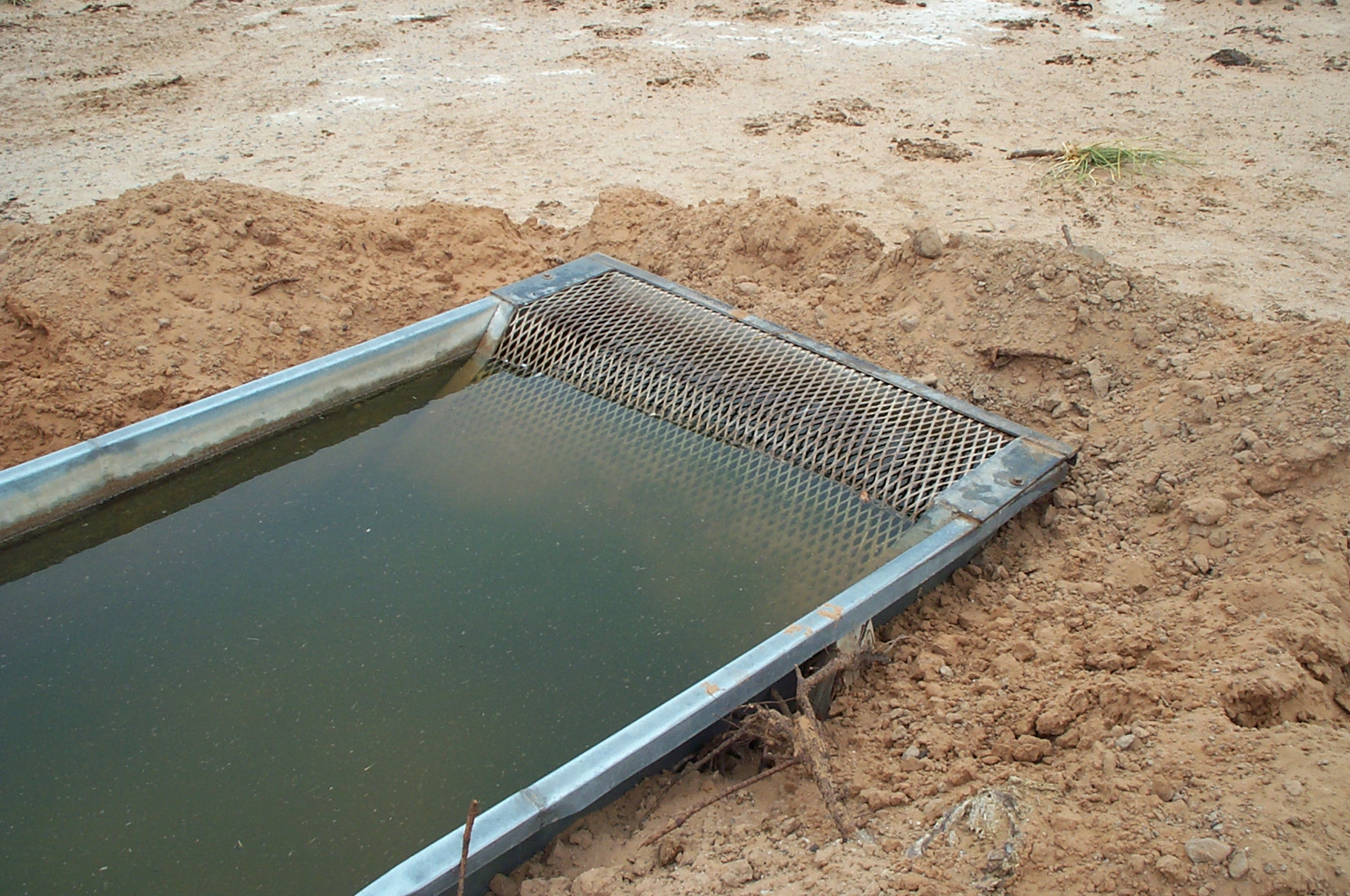
An example of a simple escape ramp that will prevent wildlife death and keep a clean water source available for livestock. (Photo courtesy of Roswell BLM)
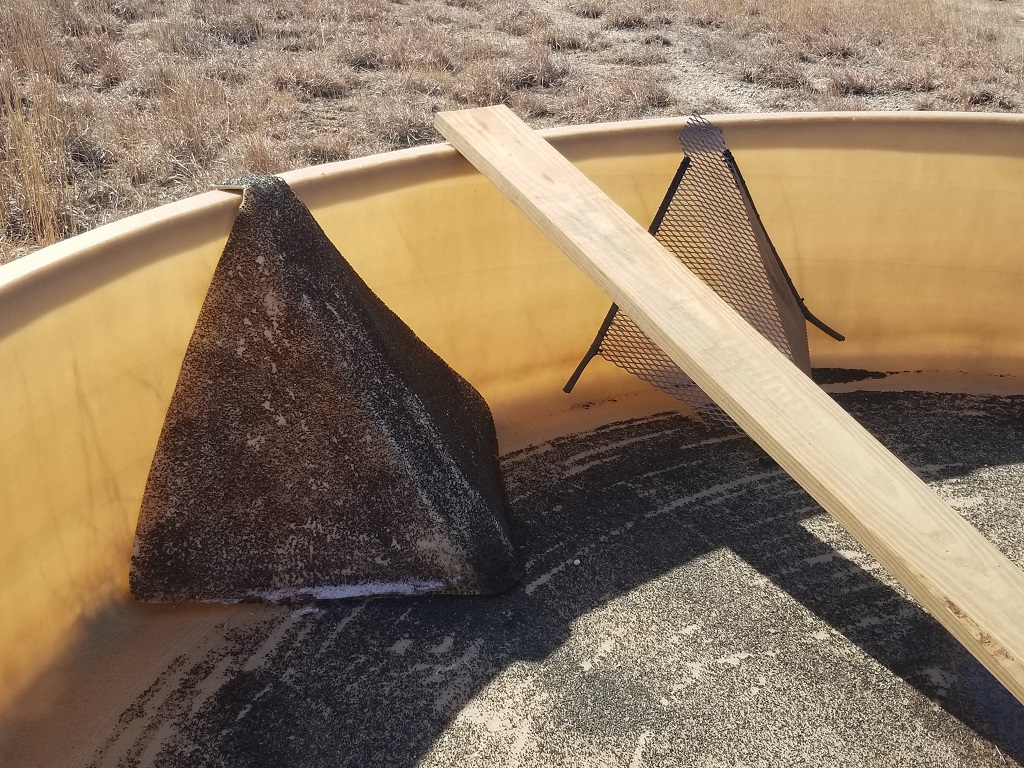
Various escape ramp designs exist. Whatever you use, make sure it is securely fastened and is positioned so animals swimming around the rim will intercept it. For example, the wooden board pictured here is not positioned correctly, but the wire and plastic ramps are. (Photo Courtesy of Weston Storer)
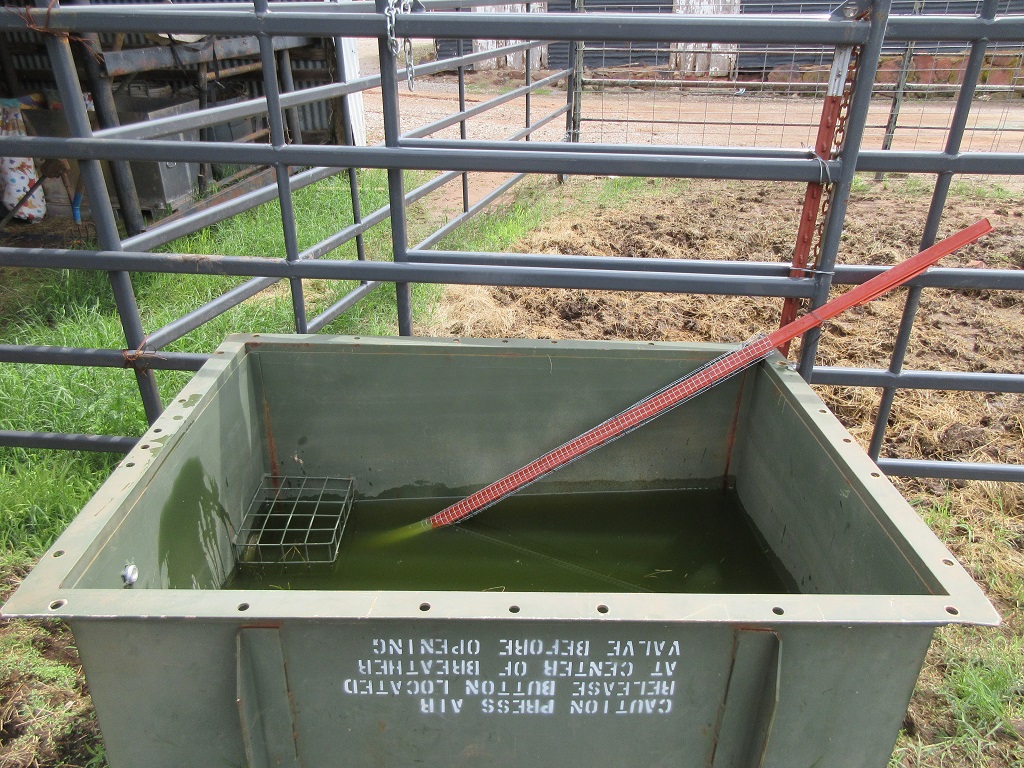
Escape ramps need not be expensive. This simple design uses a fence post wrapped in poultry wire. Note that the ramp is securely fastened to the side of the tank and the wire extends to the bottom of the post, so even with low water levels, wildlife can escape.
Water Levels: Keep it High or Dry
One of the simplest ways to prevent wildlife from drowning is by maintaining appropriate water levels. When livestock are moved between pastures, it can be easy to neglect the water levels of troughs if livestock are not present. However, keeping troughs full of water can reduce the risk of wildlife drowning.
Small animals that perch on troughs to drink must lean down over the rim to reach the water. If water levels are high, these animals can easily reach the water and are less likely to fall into the trough. In the event an animal does fall in, high water levels will allow them to easily reach the rim and climb back out. Low water levels may lead small animals to jump or fall in to reach the water. Once inside the trough, the distance between the surface and the rim is too far. Some animals such as rodents or bats may be able to climb the trough walls if they are made of a rough material. However, most tanks are made of slick materials or made slippery by the water.
If you are hesitant to keep water troughs constantly full when livestock are removed from a pasture, consider draining them so they are completely dry. Even when escape structures are not present, trapped birds and bats will have an easier time taking flight from a dry surface. Therefore, when livestock are moved, an all-or-nothing approach is recommended: either keep the water levels in the tank high, or make sure to dry them out completely. If practical, the empty tank also can be flipped over to prevent wildlife from being trapped.
Inside the Trough: Escape Features
Regardless of water levels, wildlife escape ramps are a reliable way to help wildlife
and insects climb out of livestock troughs. These ramps are inexpensive and easily
attached to existing troughs. Ramps can be made from a variety of materials including
expanded metal grating, concrete, rock and mortar or fiberglass. Even old fence posts
wrapped in poultry wire can be used. Ramps can be modified to fit to a variety of
trough types including tires. No matter which design is used, all effective escape
ramps must be:
- made of a durable, graspable material,
- positioned to reach from the bottom of the trough to the top of the inside wall,
- built with sides that extend below the water level,
- no steeper than a 45-degree angle,
- firmly secured,
- located to reduce interference with livestock and
- angled along the edge of the trough to intercept animals swimming along the edge.
Some frequently used escape features can be tragically ineffective. Floating sticks, logs or planks often are placed in tanks to provide a life raft for wildlife. Unfortunately, these structures are unstable and slippery, and animals that manage to climb onto floating debris may still become stranded in the center of the trough. Piles of loose rocks are another common solution, but these structures are unstable and decrease water storage capacity. Bumping by livestock or freeze-thaw patterns in the winter can shift the rocks and cause them to fall over. An effective escape ramp should touch the edge of the trough and be strongly secured so it will not collapse or come loose.
Trapped animals often swim the perimeter of the tank looking for a way out. If the ramps do not extend all the way to the inside wall of the tank, animals may swim in circles and never find the ramp. This risk is especially high in troughs made of old tires because the inside wall is curved. For existing tire troughs, simply cut the side walls of the tire so the ramp can extend all the way to the inside wall and fit the curve.
Whichever design is chosen, escape ramps should always be used if there is any chance a tank will ever be below full level. There is simply no excuse for allowing wildlife to drown in livestock water facilities.
Summary
Wildlife-friendly infrastructure can be effective, inexpensive and easy to build.
Not only do these structures minimize negative impacts to wildlife, they also can
reduce long-term costs to the livestock owner. To provide the greatest benefits for
livestock and wildlife, keep in mind the following guidelines:
- when exclusion fencing is necessary, use only as much as needed,
- fences should be highly visible and easy for wildlife to jump over or crawl under,
- use fencing materials and designs that minimize the risk of snagging/injury,
- create strategic wildlife crossings in fences such as riparian areas and known travel corridors,
- keep fences well-maintained,
- install wildlife escape ramps in water troughs and
- keep water levels high in water troughs.
These simple modifications will allow you to enjoy wildlife without compromising functionality of livestock infrastructure.
For More Information
Visibility Markers
Fence Marking for Lesser Prairie-Chickens (George Miksch Sutton Avian Research Center)
Escape Ramps
Building an Escape Ramp (Oklahoma Department of Wildlife Conservation):
Improving Wildlife Escape Structures: Design and Placement (Bat Conservation International)
Watering Facility Wildlife Escape Ramp Design (Sage Grouse Initiative):
Wildlife Escape Ramps for Livestock Watering Troughs (Oregon NRCS):
Wildlife-Friendly Troughs (NRCS)
Sources
Hanophy, W. 2009. Fencing with Wildlife in Mind. Colorado Division of Wildlife, Denver, CO, USA. 36 pp.
Paige, C. 2012. A Landowner’s Guide to Wildlife Friendly Fences. Second Edition. Private Land Technical Assistance Program, Montana Fish, Wildlife & Parks, Helena, MT, USA. 56 pp.
Spencer, C., D. Lalman, M. Rolf, and C. Richards. 2017. Estimating Water Requirements for Beef Cows. AFS-3299. Oklahoma Cooperative Extension Service, Division of Agricultural Sciences and Natural Resources, Oklahoma State University, Stillwater, OK, USA. 4 pp.
Taylor, D.A.R. and M.D. Tuttle. 2007. Water for Wildlife: A Handbook for Ranchers and Range Managers. Bat Conservation International, Austin, TX, USA. 20 pp.
Umar, S., M.T. Munir, T. Azeem, S. Ali, W. Umar, A. Rehman, and M.A. Shah. 2014. Effects of water quality on productivity and performance of livestock: A mini review.Veterinaria 2(2): 11-15.
Wyoming Game and Fish Department. 2004. Fencing guidelines for wildlife . Revised version. Habitat Extension Bulletin No. 53. Wyoming Game and Fish Department, Cheyenne, WY, USA. 12 pp.
Kiera Kauffman
Graduate Research Assistant
Dwayne Elmore
Extension Wildlife Specialist
Laura Goodman
Range Extension Specialist
